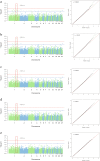Genome-wide association study reveals novel loci associated with body size and carcass yields in Pekin ducks
- PMID: 30606130
- PMCID: PMC6318962
- DOI: 10.1186/s12864-018-5379-1
Genome-wide association study reveals novel loci associated with body size and carcass yields in Pekin ducks
Abstract
Background: Pekin duck products have become popular in Asia over recent decades and account for an increasing market share. However, the genetic mechanisms affecting carcass growth in Pekin ducks remain unknown. This study aimed to identify quantitative trait loci affecting body size and carcass yields in Pekin ducks.
Results: We measured 18 carcass traits in 639 Pekin ducks and performed genotyping using genotyping-by-sequencing (GBS). Loci-based association analysis detected 37 significant loci for the 17 traits. Thirty-seven identified candidate genes were involved in many biological processes. One single nucleotide polymorphism (SNP) (Chr1_140105435 A > T) located in the intron of the ATPase phospholipid transporting 11A gene (ATP11A) attained genome-wide significance associated with five weight traits. Eight SNPs were significantly associated with three body size traits, including the candidate gene plexin domain containing 2 (PLXDC2) associated with breast width and tensin 3 (TNS3) associated with fossil bone length. Only two SNPs were significantly associated with foot weight and four SNPs were significantly associated with heart weight. In the gene-based analysis, three genes (LOC101791418, TUBGCP3 (encoding tubulin gamma complex-associated protein 3), and ATP11A) were associated with four traits (42-day body weight, eviscerated weight, half-eviscerated weight, and leg muscle weight percentage). However, no loci were significantly associated with leg muscle weight in this study.
Conclusions: The novel results of this study improve our understanding of the genetic mechanisms regulating body growth in ducks and thus provide a genetic basis for breeding programs aimed at maximizing the economic potential of Pekin ducks.
Keywords: Body size; Carcass trait; Genome-wide association study; Pekin duck.
Conflict of interest statement
Ethics approval and consent to participate
Animal experiments were approved and performed according to the Animal Care and Use Committee of China Agricultural University (permit number: SYXK 2007–0023).
Consent for publication
Not Applicable.
Competing interests
The authors declare that they have no competing interests.
Publisher’s Note
Springer Nature remains neutral with regard to jurisdictional claims in published maps and institutional affiliations.
Figures


Similar articles
-
Genome-wide association study reveals novel loci associated with fat-deposition and meat-quality traits in Pekin ducks.Anim Genet. 2020 Dec;51(6):953-957. doi: 10.1111/age.12995. Epub 2020 Aug 26. Anim Genet. 2020. PMID: 32844456
-
Genome-wide association study of bone quality and feed efficiency-related traits in Pekin ducks.Genomics. 2020 Nov;112(6):5021-5028. doi: 10.1016/j.ygeno.2020.09.023. Epub 2020 Sep 11. Genomics. 2020. PMID: 32927007
-
Genome-wide association analysis identifies candidate genes for carcass yields in Peking ducks.Anim Genet. 2024 Dec;55(6):833-837. doi: 10.1111/age.13480. Epub 2024 Oct 8. Anim Genet. 2024. PMID: 39377540
-
The study of candidate genes in the improvement of egg production in ducks - a review.Poult Sci. 2022 Jul;101(7):101850. doi: 10.1016/j.psj.2022.101850. Epub 2022 Mar 11. Poult Sci. 2022. PMID: 35544958 Free PMC article. Review.
-
PLAG1 and NCAPG-LCORL in livestock.Anim Sci J. 2016 Feb;87(2):159-67. doi: 10.1111/asj.12417. Epub 2015 Aug 11. Anim Sci J. 2016. PMID: 26260584 Free PMC article. Review.
Cited by
-
Glycine rich proteins of ticks: more than a cement component.Parasitology. 2024 Aug;151(9):1063-1073. doi: 10.1017/S0031182024001410. Parasitology. 2024. PMID: 39632718 Free PMC article. Review.
-
A cost-effective oligo-based barcode system for chromosome identification in longan and lychee.Hortic Res. 2024 Sep 28;12(1):uhae278. doi: 10.1093/hr/uhae278. eCollection 2025 Jan. Hortic Res. 2024. PMID: 39845644 Free PMC article.
-
Genome-Wide Association Study of Growth and Feeding Traits in Pekin Ducks.Front Genet. 2019 Jul 26;10:702. doi: 10.3389/fgene.2019.00702. eCollection 2019. Front Genet. 2019. PMID: 31404312 Free PMC article.
-
In silico and in vitro study of Mycobacterium tuberculosis H37Rv uncharacterized protein (RipD): an insight on tuberculosis therapeutics.J Mol Model. 2022 May 27;28(6):171. doi: 10.1007/s00894-022-05148-1. J Mol Model. 2022. PMID: 35624324
-
miRNA-mRNA integrated analysis reveals candidate genes associated with salt stress response in Halophytic Sonneratia apetala.RNA Biol. 2025 Dec;22(1):1-13. doi: 10.1080/15476286.2025.2496097. Epub 2025 Apr 28. RNA Biol. 2025. PMID: 40296366 Free PMC article.
References
-
- Sanchez M, Govignon-Gion A, Croiseau P, Fritz S, Hozé C, Miranda G, Martin P, Barbat-Leterrier A, Letaïef R, Rocha D, et al. Within-breed and multi-breed GWAS on imputed whole-genome sequence variants reveal candidate mutations affecting milk protein composition in dairy cattle. Genet Sel Evol. 2017;49(1):68. - PMC - PubMed
MeSH terms
Grants and funding
LinkOut - more resources
Full Text Sources
Miscellaneous

